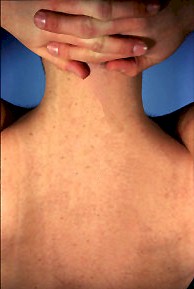
|
|
|
|
|
|
|
|
|
|
|
|
|
|
|
|
|
|
|
|
|
|
|
|
|
|
|
|
|
|
|
|
|
|
|
|
|
|
|
|
|
|
|
|
|
|
|
|
|
|
|
|
|
|
|
|
|
|
|
|
|
|
|
|
Frequently Asked Questions |
     |
What is Chiropractic?
Chiropractic is a natural healing art that developed from the research and clinical work done by Dr. D.D. Palmer in 1895, in Davenport, Iowa. Since then, Chiropractic has grown to the second largest primary healing art in the United States. Doctors of Chiropractic are now licensed in all 50 States and most Western Nations. The State of New Hampshire has been licensing Doctors of Chiropractic since 1923.
Chiropractic is based on three basic principals:
- Disease may be caused by irritation of the nervous system.
- Irritation of the nervous system may be caused by alterations of the musculoskeletal system. These alterations are typically misalignments and/or dysfunctions of the joints of the spine and the related structures. In Chiropractic, these are referred to as subluxations.
- Correction of subluxations, and the subsequent relief of nervous system irritation, may reduce or eliminate disease in various parts or functions of the body.
Chiropractors relieve the body of subluxations. Although they usually focus on the spinal column, Chiropractors can evaluate and treat the entire nervous, muscular and skeletal systems for such dysfunctions. Free of subluxations, your body is more balanced, has improved function, and can deal with the daily physical and emotional stresses of your life.
What kind of education does a Chiropractor have?
Is Chiropractic care safe?
Chiropractic care is safe enough to be of use for your newborn infant as well as for your 90 year old grandmother!
- Researcher A. Terrett, in a review of literature between 1934 and 1994, found Chiropractic to be the safest in the delivery of vertebral manipulation.
- The risk of death from using NSAIDS (ie: ibuprophen) is 400 times the risk from manipulation, when performed by a Chiropractor.
- Chiropractors are the musculoskeletal specialists, with the greatest degree of education and experience in this field.
- In an evaluation of musculoskeletal competency, 82% of Medical Graduates
fail to demonstrate basic competency. 1
- 85 Residents who graduated from 37 Medical schools were tested
- 43% of Orthopedic Residents Failed
- 87% of Medical Residents Failed
- 82% of Surgical Residents Failed
- 85 Residents who graduated from 37 Medical schools were tested
1. Freedman KB, Bernstein J., The Inadequacy of Medical School Education in Musculoskeletal Medicine. Journal of Bone and Joint Surgery, 80-A:1421-1427. Oct. 1998.
Is Chiropractic care effective?
Chiropractic care has been evaluated extensively over the past fifty years to determine it's safety and effectiveness for spinal conditions. In fact, no other health care modality has been researched to the extent as has been done to evaluate Chiropractic effectiveness for low back pain relief. Although the majority of Chiropractic research has been in regard to low back pain, current research is providing evidence of a myriad of other health benefits.
The "Agency for Health Care Policy & Research (AHCPR) Guidelines on Acute Low Back Problems", a report from the Federally funded agency of the U.S. Department of Health & Human Services, found Chiropractic care of acute low back pain to be safe, more effective than pharmaceutical therapies or surgery, and less costly than drugs or surgery.
A report from T. W. Mead, et. al., entitled "Low back pain of mechanical origin: Randomized comparison of Chiropractic and hospital outpatient treatment," which was published in the British Medical Journal in 1990, concluded that:
- "Our trial showed that Chiropractic is a very effective treatment, more effective than conventional hospital out-patient treatment for low-back pain, particularly in patients who had back pain in the past and who got severe problems. So in other words, it is most effective in precisely the group of patients that you would like to be able to treat...One of the unexpected findings was that the treatment differences---the benefit of Chiropractic over hospital treatment---actually persists for the whole of that three-year period...it looks as though the treatment that the Chiropractors give does something that results in a very long-term benefit."
Is Chiropractic care expensive?
Not at all! Several studies have demonstrated the cost effectiveness of Chiropractic in relation to other forms of care for the same conditions. Chiropractic care repeatedly proves to be cheaper than other treatment methods.
- In a report by S. Wolk, "Chiropractic vs. Medical Care: A Cost Analysis of Disability and Treatment for Back-Related Workers' Compensation Cases," the cost of Chiropractic care was only 55% and 56% of Medical care for nonsurgical and surgical patients, respectively.
Foundation for Chiropractic Education and Research, 1988.
- P.S. Ebral studied mechanical low back pain cases, and found that, on the
average, those receiving Chiropractic care only lost 6.26 days of work and
paid $392 for care, as compared to those receiving Medical care who lost 25.56 days
of work and paid $1,569 for care.
Ebral, P.S., "Mechanical Low-Back Pain: A Comparison of Medical and Chiropractic Management within the Victorian Work Care Scheme", Chiropractic Journal of Australia. 22(2):47-53. 1992
Who can receive Chiropractic care?
Anyone with a spine! Chiropractic care is a safe and effective way of treating people of all ages and walks of life. We care for spines from 2 days to 102 years old. Infants, children, adolescents, expecting mothers, middle aged or elderly, all spines need proper care.
Occasionally, someone presents to our office with a condition that would prohibit us from treating them Chiropractically, but this is a rare occurrence. Since each case and condition should be evaluated and treated independently, it is best to discuss your options with the Chiropractor directly.
Who is using Chiropractic?
-
73% of adults say that they would use chiropractic. 1
-
67% of adults say that alternative care inclusion is important in choosing a health plan. 1
-
31% of adults say that it is very important. 1
-
42% with annual incomes of less than $20,000 say that it is very important. 1
-
Usage of Chiropractic care had DOUBLED in the last 15-20 years.
-
42% of the US population have sought alternative care. 1
-
74% of those using alternative forms of care, including Chiropractic, use it along with traditional care. 1
-
30% of users of alternative health care experienced a decrease in the number of visits to their MDs. 1
-
31% (61 million) of all adult Americans have visited a Chiropractor in the last 12 months. 3
1. The Landmark Report on Public Perceptions of Alternative Care, Landmark Healthcare, Inc. 1998.
2. Chiropractic in the United States: Training, Practice, and Research. Agency for Health Care Policy and Research, publication98-N002, 1997.
3. Dynamic Chiropractic, "Chiropractic Use Going Up!", 16(5), 1998.
Will I need X-rays?
Not necessarily! A lot of people assume that all Chiropractors x-ray all their patients all the time. This couldn't be further from the truth.
X-rays are a means of diagnostic evaluation. As with other diagnostic tools, they are necessary in some cases, not necessary in others, and contra-indicated in a few.
We NEVER x-ray a woman we know or suspect to be pregnant!
We SELDOM x-ray anyone under the age of 18 years old.
We AVOID x-raying nursing women if possible.
Although x-rays are deemed safe, excessive exposure can be harmful to the body. For this reason, we impose various restrictions on our use of this form of diagnosis.
Since every case is unique, it is best to discuss your concerns about x-rays with the Doctor.
How long will I have to be under care?
That all depends on you. Every case, every condition, every person we see is different. There is no magical formula to determine how long a patient will need care or how much care must be rendered.
We treat all of our patients on an individual basis, determining your response to care and what follow-up is required at each visit. As your body responds and changes, your treatment type and schedule are altered for the greatest results. Like you, we want to see fast, long-lasting results because we take pride in our work.
In order to speed yourself along in the healing process, you can take several steps in your daily life.
- Rest. The body requires energy to heal. Allowing for enough rest and avoiding over exertion helps the body provide the necessary energy.
- Eat well. If a mason doesn't have enough bricks, he cannot build a wall. Likewise, if you don't provide the proper building blocks, your body cannot complete it's task.
- Drink plenty of water. It's the single most important element in your body...need we say more?
- Avoid alcohol, tobacco, recreational drugs and excessive physical activity.
- Limit stress/relax.
- Follow the Doctor's instructions.
Over all...Be Patient! Healing takes time. Chances are, it took long time for you to get this way...It will take time to get better.
Could I become addicted to Chiropractic?
If you mean "Could I get addicted to a feeling of wellness and health, in which my body functions at the greatest possible level, where I have more energy, strength and stamina, and am able to perform my daily activities in the safest and most efficient manner?" Then...yes, you may never want to stop.
But if you are referring to the over used adage, "Once you go to a Chiropractor, you have to keep going forever," then the answer is a firm, "NO".
Those who choose to make Chiropractic a long-term or life-long addition to their personal health habits do so, primarily, as a form of preventative health care, much like a healthy diet or exercise.
There is nothing about Chiropractic treatments/adjustments that would cause a need for extended care. On the contrary, research has shown that the benefits of Chiropractic care are longer lasting than those achieved by Medical care for some conditions. (See "Is Chiropractic care effective?")
Couldn't I just "crack" my own back/neck? (Or have a friend do it for me?)
Anyone can move bones. Anyone can make joints "pop". Not just anyone can do it right.
Chiropractors have extensive, specialized training in the art, science and philosophy associated with spinal manipulation.
The sensation of tightness, restriction or pain that you are feeling in your back or neck is caused by a jammed or fixated bone (vertebra) or joint. Often, this fixated joint is accompanied by one or more joints that moves too much (hypermobile), as a compensation. When you, or a friend, "crack" or "pop" your spine, you are introducing a force and a motion into a series of bones. Without the proper control of this force, it will tend to be taken up by the hypermobile joints, since they are easier to move. The fixated joint stays fixed...the hypermobile joints are forced to move even more. Not only does the problem remain...it gets worse.
"But I feel better when I crack my neck (back)." -- Research shows that the mobilization of joints, whether they need it or not, causes the body to release special pain killing compounds, known as endorphins and enkephlins, which cause a brief period of euphoria and pain relief. If the proper correction is not performed, the pain returns when the 'pain killers' wear off. That's why most self-adjusters need to "crack" themselves more and more all the time, until they do it every few minutes. The more they do it, the worse they get, the more they need to do it...
When a Chiropractor performs an adjustment, he/she controls the force/motion to alleviate the fixated joint, without applying undue stress or strain to joints that are already moving enough or too much. This is why a Chiropractic student has over a thousand hours of training specifically in manipulation techniques. Add to that the years of experience that Doctor Avard has, and you have a level of care that you cannot easily match.
Can a Chiropractor treat someone after back surgery?
Absolutely! Not only is it possible for your Chiropractor to treat you after surgery, it is recommended in most cases.
Surgery traumatically alters the natural structures of the body. Like other forms of trauma, the typical process is for scar tissue to develop, biomechanics to be altered, and supportive tissues (muscles, ligaments, tendons and cartilage) to become compromised. Chiropractic care helps to maintain the highest degree of function in the tissues and joints surrounding the surgical site. Although the body needs time to heal after surgery, visiting a Chiropractor regularly may help to prevent future problems from developing.
|
Dr. John B. Avard, Chiropractor 49 South River Road, Bedford, NH 03110 (603) 623-3030 © Dravard.com 2007 All rights reserved. |
